Time Expression and Named Entity Recognition by Xiaoshi Zhong & Erik Cambria

Author:Xiaoshi Zhong & Erik Cambria
Language: eng
Format: epub
ISBN: 9783030789619
Publisher: Springer International Publishing
We find that time expressions are formed by loose structure and the loose structure mainly exhibits in the following two aspects. Firstly, many time expressions consist of loose collocations. For example, the time token âSeptemberâ can form a time expression by itself, or forms âSeptember 2006â by another time token appearing after it, or forms â1 September 2006â by a numeral appearing before it and another time token appearing after it. Secondly, some time expressions can change their word order without changing their meanings. For example, âSeptember 2006â can be written as â2006 Septemberâ with the same meaning. From the point of view of the positions within time expressions, the time token âSeptemberâ may appear as the (i) beginning or (ii) inside word of a time expression when time expressions are modeled by the BIO scheme; or it may appear as (1) a unit-word time expression, or the (2) beginning, (3) inside, (4) last word of a multi-word time expression when time expressions are modeled by the BILOU scheme.
Table 3.6 presents the percentages of distinct time tokens and distinct modifiers that appear in different positions within time expressions. âDifferent positionsâ here means the two different positions under the BIO scheme and at least two of the four different positions under the BILOU scheme. For each dataset, under the BIO scheme, more than 53.5% of distinct time tokens appear in different positions, and under the BILOU scheme, more than 61.4% of distinct time tokens appear in different positions. The number of modifiers that appear in different positions is more than 27.5%. When the BIO scheme or the BILOU scheme is used to model time expressions, the appearance in different positions leads to inconsistent tag assignment, and the inconsistent tag assignment causes difficulty for statistical models to model time expressions. We need to explore an appropriate tagging scheme (see Sect. 5.â1 for details). Table 3.6Percentage of distinct time tokens and distinct modifiers that appear in different positions within time expressions
Download
This site does not store any files on its server. We only index and link to content provided by other sites. Please contact the content providers to delete copyright contents if any and email us, we'll remove relevant links or contents immediately.
Deep Learning with Python by François Chollet(12949)
A Developer's Guide to Building Resilient Cloud Applications with Azure by Hamida Rebai Trabelsi(10291)
Hello! Python by Anthony Briggs(10192)
The Mikado Method by Ola Ellnestam Daniel Brolund(10092)
OCA Java SE 8 Programmer I Certification Guide by Mala Gupta(10034)
Dependency Injection in .NET by Mark Seemann(9580)
Hit Refresh by Satya Nadella(9011)
Algorithms of the Intelligent Web by Haralambos Marmanis;Dmitry Babenko(8581)
The Kubernetes Operator Framework Book by Michael Dame(8322)
Exploring Deepfakes by Bryan Lyon and Matt Tora(8124)
Robo-Advisor with Python by Aki Ranin(8053)
Practical Computer Architecture with Python and ARM by Alan Clements(8053)
Implementing Enterprise Observability for Success by Manisha Agrawal and Karun Krishnannair(8036)
Sass and Compass in Action by Wynn Netherland Nathan Weizenbaum Chris Eppstein Brandon Mathis(7960)
Grails in Action by Glen Smith Peter Ledbrook(7938)
Building Low Latency Applications with C++ by Sourav Ghosh(7924)
Svelte with Test-Driven Development by Daniel Irvine(7920)
Test-Driven iOS Development with Swift 4 by Dominik Hauser(7885)
Becoming a Dynamics 365 Finance and Supply Chain Solution Architect by Brent Dawson(7837)
